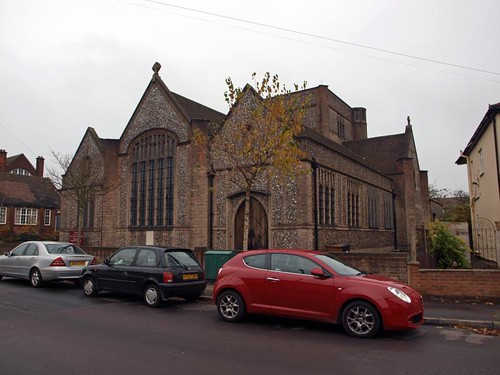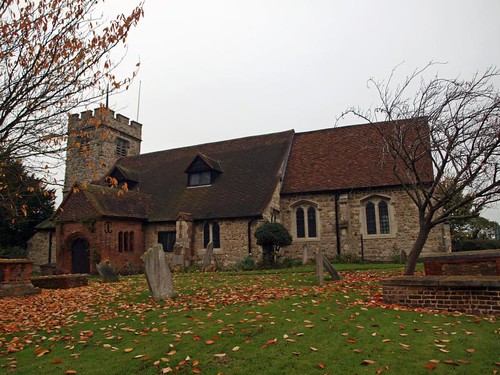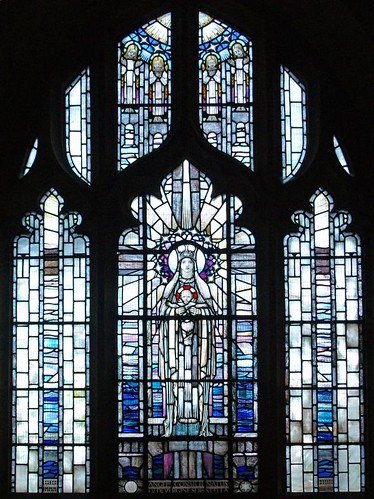This was genuinely coincidental since the only reason I knew it was there was because I'd spotted it when adding a placemark on Google maps but was unable to find a name for it until the visit.
St Edmund is one of those new builds that I should instinctively dislike but actually thought it worked well as a construct; All Saints is the original medieval church but pretty run of the mill/over restored; SS Peter & Paul is a big, blowsy Victorian vulgarity at its height; Our Lady of Grace is a pretty dull 1930's Arts & Crafts style build but has some good later internal features.
ALL SAINTS. High up with a W view towards the reservoirs of the Lea valley and the Brimsdown power station. Late C13 S arcade with circular piers and double-chamfered arches. The external features Perp. The chancel was building in 1465, when money was left in a will ‘versus fabricham novi cancelli sive chori ’. Restored after a long period of unchecked decay in 1929. Nave, chancel, and W tower. The material is rag-stone. Brick porch early C16. - PLATE. Cup and Paten of 1595. - MONUMENTS. All minor. Mary Leigh d. 1602, small tablet with reclining woman and baby behind her, in relief. - Sir Robert Leigh d. 1612, Margaret Leigh d. 1624, both with kneeling figures.
ST PETER AND ST PAUL, The Green. 1844 by Vulliamy. The E parts by Sir Reginald Blomfield 1903, white brick with much flushwork decoration. An uncommonly bold way of adding. The old church had a W tower with spire, no aisles, and a W gallery. The new parts are aisled and three bays long, added without any compromise so that the old nave seems a kind of roofed forecourt. - FONT. Purbeck marble, square, C12, with five shallow blank arches to each side of the bowl. - PULPIT. Good early C18. - PLATE. Paten on foot 1699; Flagon 1705.
Pevsner mentions neither St Edmund nor Our Lady of Grace but Taking Stock's entry for the latter can be found here.
 | ||
| SS Peter & Paul |
CHINGFORD. High on a hill overlooking the River Lea, it is famous among that great multitude which comes to visit Epping Forest. There are woods in which naturalists find rare treasures and a lake of much beauty known as Connaught Water, with a fine survival of the past close by. It is Queen Elizabeth’s hunting lodge, and was called a Standing, a place where spectators stood to watch the hunt. It has been transformed into a museum, and a rare old place it is, three storeys high, with one of the finest staircases in Essex, its stairs six feet wide and so easy to mount that we may well believe the story that Elizabeth rode up them on her pony. The timbers of the lodge are 16th century, the tapestry on the middle floor is 17th. One of the odd things we see here is the kind of wooden pipe which was used for carrying London’s water up to the beginning of last century. It is a long hollowed-out trunk.
We meet an old neighbour of the Standing a mile away from the old church, Pimphall Farm. It is a timbered house of the 16th century with a barn of five bays not quite so old, and one of the best timbered dovecots in Essex. There is a quaint story of an Act of Homage by which this farm was held in olden time. It seems that the farm was given to a huntsman, probably by the king, on condition that the farmer did homage to the rector. This is the Act of Homage performed in 1659:
Samuel Haddon with his wife and two servants came to the rectory and blew three blasts with a horn, receiving from the rector a chicken for his hawk, a peck of oats for his horse, a loaf of bread for his hound, and a dinner for himself and his wife, his man and his maid. After dinner he blew three blasts and paid twelve pence, and so departed.
One other unusual monument we find at Chingford, an obelisk set up by the Ordnance Survey to mark the meridian of Greenwich, which was used until 1884 when a new zero line was adopted by international agreement.
There is an old church and a new one. The new one is on Chingford Green, with a font and a finely carved 17th century pulpit from the old church, and a table in the children’s corner carved with animals; the old one is on a knoll a mile from the heart of the town.
Long neglected as a ruin, it has been well restored and has still a 13th century doorway, a medieval aisle and chancel, and Norman stones in the nave. The tower is 500 years old, and at the top of one of its beams has been placed a 13th century stone cross with a head on each side of the base. There is a 17th century chest with three locks, and two doors are still hanging on their 15th century hinges.
On a wall is a woman mourning at an urn in memory of John Heathcote, an 18th century man of science. There are many memorials to the Leighs. Sir Robert kneels in Jacobean armour, and Margaret kneels at prayer on another monument with a symbolical figure of Time. Mary Leigh, an Elizabethan lady, rests on the wall with a baby beside her. We noticed that Robert Lewis was vicar here half a century, through all the days while Napoleon was terrifying Europe.
Flickr.
And so to bed (or rather in 2014 to Hertfordshire to finish off 172 remaining churches).
We meet an old neighbour of the Standing a mile away from the old church, Pimphall Farm. It is a timbered house of the 16th century with a barn of five bays not quite so old, and one of the best timbered dovecots in Essex. There is a quaint story of an Act of Homage by which this farm was held in olden time. It seems that the farm was given to a huntsman, probably by the king, on condition that the farmer did homage to the rector. This is the Act of Homage performed in 1659:
Samuel Haddon with his wife and two servants came to the rectory and blew three blasts with a horn, receiving from the rector a chicken for his hawk, a peck of oats for his horse, a loaf of bread for his hound, and a dinner for himself and his wife, his man and his maid. After dinner he blew three blasts and paid twelve pence, and so departed.
One other unusual monument we find at Chingford, an obelisk set up by the Ordnance Survey to mark the meridian of Greenwich, which was used until 1884 when a new zero line was adopted by international agreement.
There is an old church and a new one. The new one is on Chingford Green, with a font and a finely carved 17th century pulpit from the old church, and a table in the children’s corner carved with animals; the old one is on a knoll a mile from the heart of the town.
Long neglected as a ruin, it has been well restored and has still a 13th century doorway, a medieval aisle and chancel, and Norman stones in the nave. The tower is 500 years old, and at the top of one of its beams has been placed a 13th century stone cross with a head on each side of the base. There is a 17th century chest with three locks, and two doors are still hanging on their 15th century hinges.
On a wall is a woman mourning at an urn in memory of John Heathcote, an 18th century man of science. There are many memorials to the Leighs. Sir Robert kneels in Jacobean armour, and Margaret kneels at prayer on another monument with a symbolical figure of Time. Mary Leigh, an Elizabethan lady, rests on the wall with a baby beside her. We noticed that Robert Lewis was vicar here half a century, through all the days while Napoleon was terrifying Europe.
Flickr.
And so to bed (or rather in 2014 to Hertfordshire to finish off 172 remaining churches).



No comments:
Post a Comment